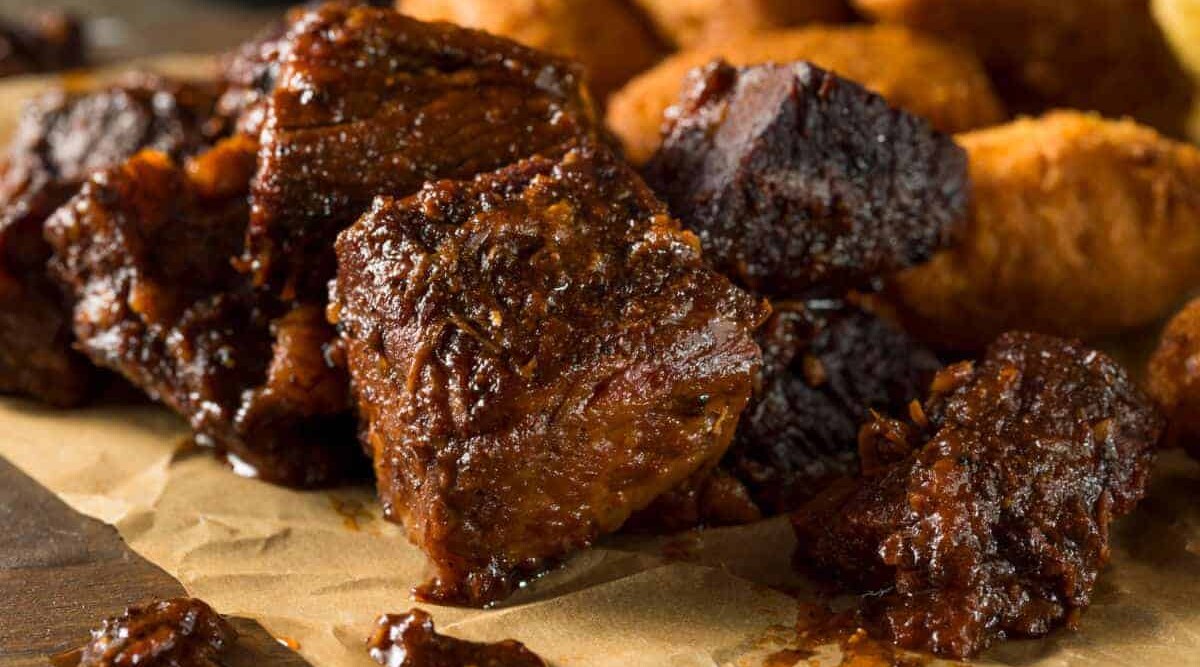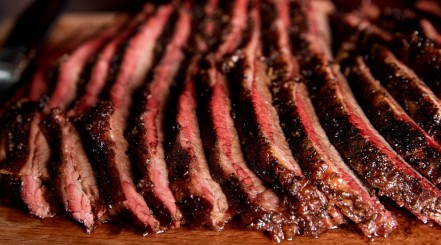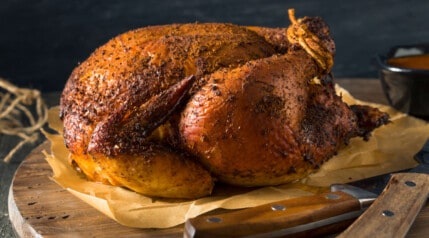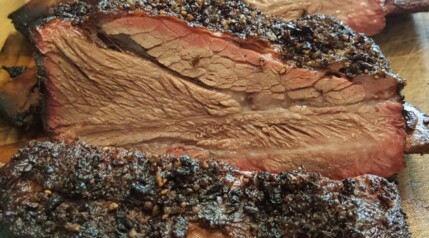
For many of us, there is no better bite of barbecue than brisket burnt ends.
A properly cooked burnt end has everything that can possibly go into great barbecue. It has deep, chewy bark on the outside with intense smokey flavor, paired with a sweet sticky sauce, and is cooked until it’s as tender as your Momma’s love.
Ever wanted to learn more about burnt ends? What they are, what their history is, and (most importantly) how to make burnt ends?
Keep reading, and we’ll answer all those questions, plus another couple you probably didn’t even realize you had, as well as provide an easy-to-follow, printable recipe, so you can make them yourself.
Jump to:
The History of Burnt Ends
Brisket is actually 2 muscles, the leaner flat and the fattier point. Burnt ends are made from the fattier point part of the brisket.
Since brisket is king in Texas, it’s understandable that many think burnt ends are a tradition of the lone star state, given its affinity with smoked brisket, but they would be wrong.
Surprisingly, burnt ends were invented in Kansas City, Missouri.
Kansas City may seem unlikely to be the home to one of the greatest food inventions of all-time, but I assure you Kansas City is steeped in barbecue traditions.
It is home to both the Kansas City BBQ Society — the largest BBQ contest sanctioning body in the world, and The American Royal World Series of Barbecue® — one of the largest BBQ contests in the world.
Also, Kansas City is home to Arthur Bryant’s Barbecue, a restaurant that has served the likes of Presidents and movies stars. At Arthur Bryant’s you order your food at a counter, and your meat is cut to order.
KCPT produced an excellent documentary about the history of the burnt end called Burnt Legend. In the video below, they do a great job of explaining how the burnt end of today came to be, and how Arthur Bryant’s played such a major part in that.
Where the Name Burnt Ends Comes From — and How They Used to be Given Away Free!
Many years ago it was customary for the person doing the cutting to cut off the charred end pieces of the point of the brisket and place them on a plate for customers to snack on while waiting for their food.
These pieces had a lot of bark, were somewhat dried out, and were considered unfit to be sold.
As time went on, these little pieces of brisket became very popular. So popular that customers began asking if they could become a menu item.
This presented a unique problem. The demand was so great, but the supply was so small. Each brisket would only yield a few small scraps of these burnt edges, not enough for a sandwich.
To replicate the burnt edges they were giving away, Arthur Bryant’s had to come up with a way to similarly prepare their brisket.
They began to cook the point about 80% of the way, and then cube it and cover it in their thick sauce, and finally return them to the smoker to finish cooking.
And this gave birth to the common burnt end we all know and love today.
How to Make Burnt Ends?
There is some misconception out there that burnt ends are just cubed pieces of brisket that have been sauced. This is a travesty to good burnt ends everywhere, especially since you already had everything you needed to make proper burnt ends.
A brisket consists of two main parts. The flat is leaner and as the name suggests is flat and broad. This is perfect for slicing.
The other part is the point, which is much fattier than the flat. The point is what we want to use when making burnt ends.
Cook the point until it’s almost ready, then remove it and using a good brisket slicing knife, cut it into large 1” diameter cubes before saucing and returning to the smoker.
This will allow the meat to continue cooking causing both the intramuscular fat to render down and create a delicious bark on the exterior of the burnt end.
Video: How to make Burnt Ends by HowToBBQRight
In this video, Malcom Reed shows you how to make burnt ends from a whole packer brisket, with commercial rubs and sauces:
Burnt Ends Recipe
The recipe below is a simple way for you to make burnt ends at home, if you don’t fancy following the video above precisely.
Ingredients:
For the Brisket:
- 1 brisket point — approx. 6 lbs. You can purchase just the point, or you can purchase a whole brisket and separate. Cook the flat with your point, or keep it to cook later.
- ¼ cup of your favorite beef or brisket rub
- 2 cups of Kansas City Style BBQ sauce
- ¼ cup brown sugar
- ½ stick of butter
- 2 tbsp of honey
For the spritz:
- ½ cup water
- ½ cup beef broth
- 2 tbsp. Worcestershire Sauce
Instructions
- The night before your cook, trim your brisket ready for smoking. For detailed instructions, check our guide on how to trim a brisket.
- Season your brisket liberally with the rub and place in refrigerator and combine the ingredients for the spritz into a spray bottle
- Prepare barbecue for two-zone indirect cooking, and preheat to 275 °F, using hickory wood for smoke (or one of the 6 other woods we recommend for smoking brisket.)
- Place brisket on the barbecue and cook until internal temperature reaches 150 °F, spritzing every hour or so. Approx. 6 hours.
- Wrap the brisket in tinfoil, adding ¼ cup of the spritzing liquid. Add to the grill until the internal temperature hits 185° Approx. 2 hours.
- In a saucepan over medium heat combine BBQ sauce, brown sugar, butter, and honey. Stir until brown sugar is dissolved then remove from heat.
- Remove brisket from smoker and slice into 1” thick slices, and then slice into 1” thick cubes. Place the cubed brisket in a disposable pan and coat in the BBQ sauce mixture and return to the barbecue.
- Cook for another 1 – 2 hours until the BBQ sauce mixture has reduced and the burnt ends are caramelized. Serve immediately.
Conclusion
One last thing: burnt ends are only made with brisket. There’s a rising trend lately to make burnt ends out of other cuts of beef, or something different altogether like pork belly. While it may all be delicious, it is simply not a burnt end.
Now that we’ve hopefully answered all the questions you could have regarding burnt ends, please leave us a comment down below with your thoughts. Did we nail it, or do you think we’ve left out an important step or two? Do you have a recipe that you feel can rival ours? Let us know!
As always, if you’ve enjoyed this article, please share it with your friends on Facebook or other social media channels.






Beautiful. Smoked point on a Traeger, was awesome and tender. Well done.
Good work 🙂
Bought a 6 lb. “Market Trimmed” point, and had to cut 1.5 more pounds off of it (ughh). Cooked on Large Big Green Egg. Meat hit 160 degrees at less than 4 hours, cooking around 250-265. Took less than 1.5 hours with the Texas Crutch to hit 189 degrees. Pulled it, cubed it, and applied BBQ mixture as instructed.
Put pan on grill and stirred after 10 minutes to mix it all up. Mixed again after 30 more minutes. Still kind of looked the same. Checked meat temp with instant thermometer and was 181 and 182. Hmmm? Cranked heat until it hit 400, then closed vents to bring temp back down. Looked when it hit 248 after about another 30 minutes, and the meat had a such a different look — darker and more “burnt” looking. Did it again for another 30 minutes letting it hit 409 and then come back down. Checked meat temp and was 195-197. Pulled it then.
I had 7 people at my house who are still raving about how good that was. This was my first time cooking burnt ends, and was really worried when I cubed it, because it seemed kind of tough when cutting it. I guess that is because it was not done, so needed more time. The meat could not have been any more tender! I think I was more surprised than anyone. I really don’t see how it could have turned out any better.
Thank you, Mark!
Thanks for the article Mark! Burnt ends are little chunks of Heaven right here on earth. I’m looking to upgrade my Master Built (it really isn’t masterly built) propane smoker to an electric smoker. Any suggestions on good brands? I would like to keep it under a grand.
Thanks,
Russ
Hi Russ,
For an electric, I have the Masterbuilt 30 myself. I’ve not had any issues with it personally, but I’m getting to the point where my view on them is changing because so many others seem to have had issues with build quality and reliability.
However, I’m not really sure what else to recommend when it comes to electric smokers. Most models are the ‘economical / budget’ price end, so build quality is never really the best. And I see most models from most manufacturers receiving complaints in forums, Facebook groups and so on. I need to do research on it myself and update my recommendations article very soon. Sorry I can’t be more help with this one.
Great read and videos.
Very informative.
Figures something like this would be invented in Kansas City since we know how to smoke a brisket in Texas. You end up with anything burnt and dry it’s cause you suck at cooking. But they still weren’t invented in KC, maybe the idea of saucing and selling them cause we don’t do that here, again there’s that whole issue where we’re capable of smoking a brisket tender and juicy throughout. But all over there were cooks who would cut off and toss or give away burnt ends. Or the cooks would eat them. What a lie this article is.
Hi, Fletch. Care to expand on ‘What a lie this article is? It’s well researched, backed up with links to sources and a video documentary detailing all that we’re saying, so it tells things exactly how they are. If there are inaccuracies, point them out, and we’ll look into them. Thanks.
I dry brined the meat for 14 hours with 3 tsp. of Morton’s Course Kosher Salt and Big Bad Beef Rub. Also cooked on BGE indirect heat with plate setter and water pan below the meat. Hope that helps!
Just found this site on Pinterest you have done a great job of presenting this show and I am looking forward to trying these recipes thank you
Tried your recipe..loved it. Thanks for sharing
The burnt ends came out great. Thank you for the recipe. A dinner favorite
How would you suggest making ahead of serving day? refrigerate after initial smoke then cook(smoke) to warm, then continue with doing the sauce in pan etc?
I would cook until completely done, then vacuum seal to be reheated sous vide / in a pan of hot water on the day. There’s no discernible loss of quality when you vacuum seal and reheat sous vide something like this.
Was wondering about sous vide, specifically the thin plastic being cooked for long periods of time. I know your site is about bbq, just curious what you thought about this?
I sous vide now and then, but mostly reheating leftover BBQ of which I tend to have a lot due to my work here. It’s a very popular cooking technique, and becoming ever more popular year by year. I’ve never heard any issues with the bags being cooked for long periods of time (assuming you buy the correct bags made for purpose, of course.)